2019 MASERATI GRANTURISMO CONVERTIBLE coolant temperature
[x] Cancel search: coolant temperaturePage 122 of 296
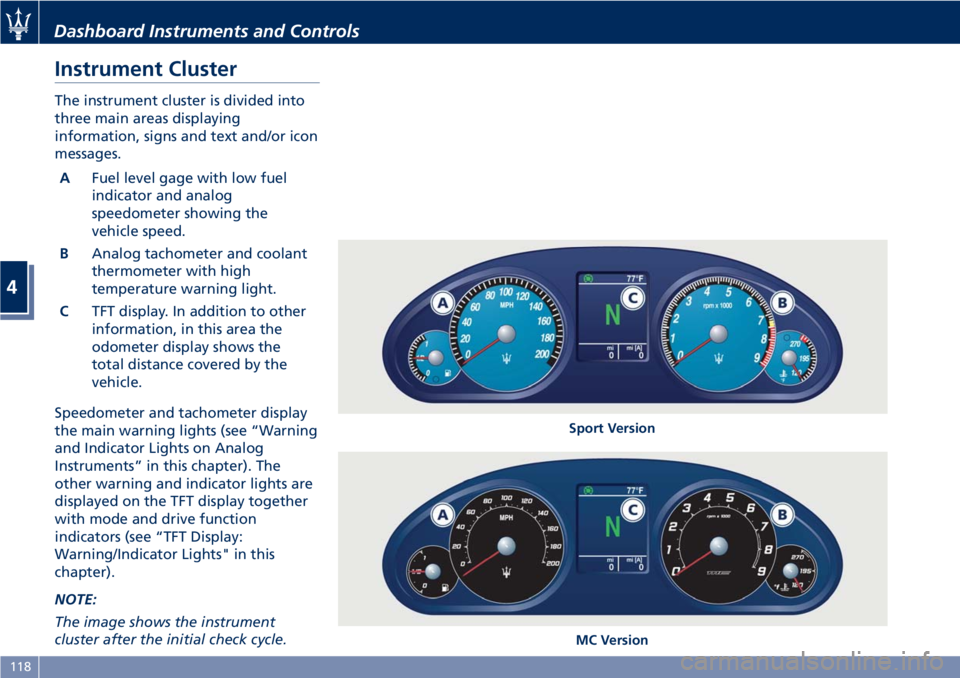
Instrument Cluster The instrument cluster is divided into
three main areas displaying
information, signs and text and/or icon
messages.
A Fuel level gage with low fuel
indicator and analog
speedometer showing the
vehicle speed.
B Analog tachometer and coolant
thermometer with high
temperature warning light.
C TFT display. In addition to other
information, in this area the
odometer display shows the
total distance covered by the
vehicle.
Speedometer and tachometer display
the main warning lights (see “Warning
and Indicator Lights on Analog
Instruments” in this chapter). The
other warning and indicator lights are
displayed on the TFT display together
with mode and drive function
indicators (see “TFT Display:
Warning/Indicator Lights" in this
chapter).
NOTE:
The image shows the instrument
cluster after the initial check cycle. Sport Version
MC VersionDashboard Instruments and Controls
4
118
Page 127 of 296
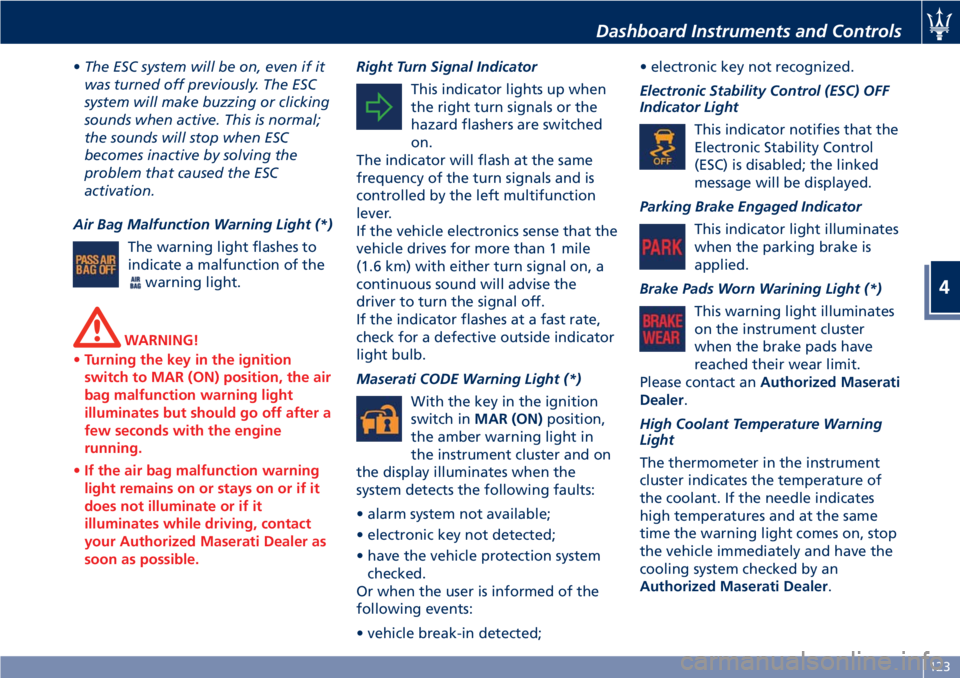
• The ESC system will be on, even if it
was turned off previously. The ESC
system will make buzzing or clicking
sounds when active. This is normal;
the sounds will stop when ESC
becomes inactive by solving the
problem that caused the ESC
activation.
Air Bag Malfunction Warning Light (*)
The warning light flashes to
indicate a malfunction of the
warning light.
WARNING!
• Turning the key in the ignition
switch to MAR (ON) position, the air
bag malfunction warning light
illuminates but should go off after a
few seconds with the engine
running.
• If the air bag malfunction warning
light remains on or stays on or if it
does not illuminate or if it
illuminates while driving, contact
your Authorized Maserati Dealer as
soon as possible. Right Turn Signal Indicator
This
indicator lights up when
the right turn signals or the
hazard flashers are switched
on.
The indicator will flash at the same
frequency of the turn signals and is
controlled by the left multifunction
lever.
If the vehicle electronics sense that the
vehicle drives for more than 1 mile
(1.6 km) with either turn signal on, a
continuous sound will advise the
driver to turn the signal off.
If the indicator flashes at a fast rate,
check for a defective outside indicator
light bulb.
Maserati CODE Warning Light (*)
With the key in the ignition
switch in MAR (ON) position,
the amber warning light in
the instrument cluster and on
the display illuminates when the
system detects the following faults:
• alarm system not available;
• electronic key not detected;
• have the vehicle protection system
checked.
Or when the user is informed of the
following events:
• vehicle break-in detected; • electronic key not recognized.
Electronic Stability Control (ESC) OFF
Indicator Light
This indicator notifies that the
Electronic Stability Control
(ESC) is disabled; the linked
message will be displayed.
Parking Brake Engaged Indicator
This indicator light illuminates
when the parking brake is
applied.
Brake Pads Worn Warining Light (*)
This warning light illuminates
on the instrument cluster
when the brake pads have
reached their wear limit.
Please contact an Authorized Maserati
Dealer .
High Coolant Temperature Warning
Light
The thermometer in the instrument
cluster indicates the temperature of
the coolant. If the needle indicates
high temperatures and at the same
time the warning light comes on, stop
the vehicle immediately and have the
cooling system checked by an
Authorized Maserati Dealer .Dashboard Instruments and Controls
4
123
Page 132 of 296

Engine Temperature Warning Light
This warning light coupled
with the light on the coolant
thermometer notifies when
the engine is overheated. If
the temperature reaches critical levels
this warning light will illuminate in red
color combined with the related
message on display.
If the indicator light switches on while
driving, safely pull over and stop the
vehicle. If the A/C system is on, turn it
off. Also, shift the transmission into N
(Neutral) and idle the vehicle. If the
temperature does not return to
normal, immediately turn the engine
off and contact an Authorized
Maserati Dealer .
Check “Engine Overheating” in section
“In an Emergency” for more
information.
Doors and Lids Open Warning Light
This warning light indicates
that the doors or lids are open
or not properly closed. The
instrument cluster display also
shows an image of the vehicle with the
part not closed highlighted in red and
the related message. WARNING!
Before starting off, close any doors
and lids that are open or not properly
closed.
Soft Top Failure Warning Light
This
warning light illuminates
if the hydraulic and electric
soft top movement systems
fail.
Fuel Cutout Enabled Warning Light
This warning light illuminates
when a collision activates the
inertia switch, thus cutting off
the fuel supply.
WARNING!
After a collision, if you smell fuel or
note leakages from the fuel system,
do not reactivate the switch in order
to prevent the risk of fire.
Windshield and Headlights Washer
Low
Fluid Indicator
This indicator will illuminate
for 10 seconds to indicate a
low level of the windshield
and headlights washer fluid. A
related message will be displayed. See “Maintenance Procedures” in
section “Maintenance and Care” for
fluid filling.
Lighting System Failure Warning Light
This warning light illuminates
in the case of a system failure
or burning-out of the position,
turn signal, rear fog and
license plate light bulbs.
See "Bulb Replacement" in section
"Maintenance and Care" for further
details.
Stop Light Failure Warning Light
This warning light illuminates
in the case of a system failure
or burning-out of the stop
light bulbs.
See "Bulb Replacement" in section
"Maintenance and Care" for further
details.
Twilight Sensor Failure Warning Light
This warning light illuminates
in the case of a failure of the
twilight sensor.
Contact an Authorized
Maserati Dealer to have the vehicle
checked.Dashboard Instruments and Controls
4
128
Page 169 of 296
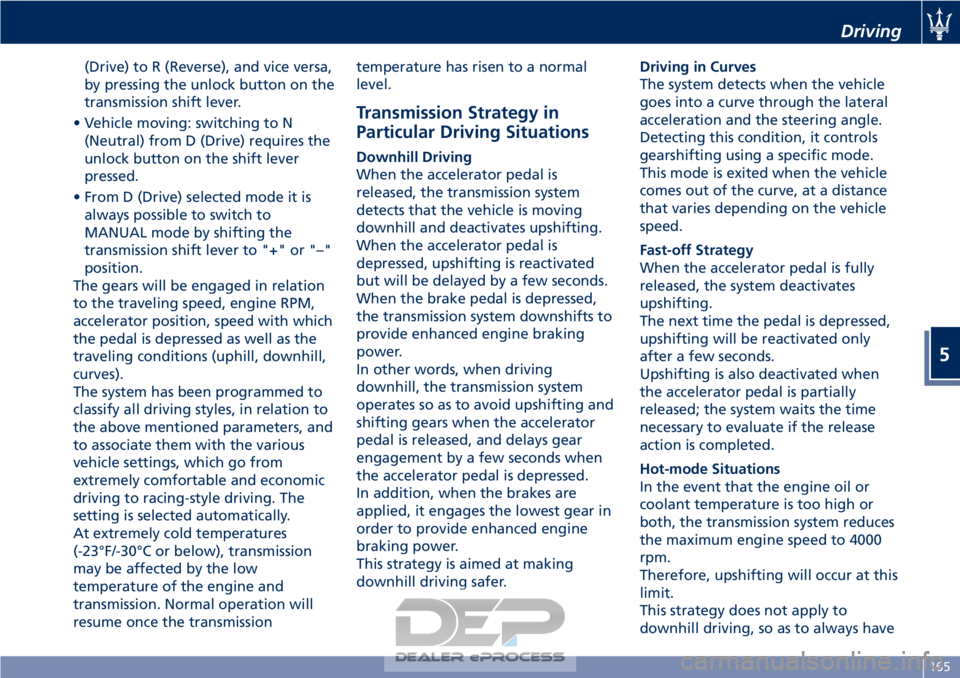
(Drive) to R (Reverse), and vice versa,
by pressing the unlock button on the
transmission shift lever.
• Vehicle moving: switching to N (Neutral) from D (Drive) requires the
unlock button on the shift lever
pressed.
• From D (Drive) selected mode it is always possible to switch to
MANUAL mode by shifting the
transmission shift lever to "+" or "–"
position.
The gears will be engaged in relation
to the traveling speed, engine RPM,
accelerator position, speed with which
the pedal is depressed as well as the
traveling conditions (uphill, downhill,
curves).
The system has been programmed to
classify all driving styles, in relation to
the above mentioned parameters, and
to associate them with the various
vehicle settings, which go from
extremely comfortable and economic
driving to racing-style driving. The
setting is selected automatically.
At extremely cold temperatures
(-23°F/-30°C or below), transmission
may be affected by the low
temperature of the engine and
transmission. Normal operation will
resume once the transmission temperature has risen to a normal
level.
Transmission Strategy in
Particular Driving Situations
Downhill Driving
When the accelerator pedal is
released, the transmission system
detects that the vehicle is moving
downhill and deactivates upshifting.
When the accelerator pedal is
depressed, upshifting is reactivated
but will be delayed by a few seconds.
When the brake pedal is depressed,
the transmission system downshifts to
provide enhanced engine braking
power.
In other words, when driving
downhill, the transmission system
operates so as to avoid upshifting and
shifting gears when the accelerator
pedal is released, and delays gear
engagement by a few seconds when
the accelerator pedal is depressed.
In addition, when the brakes are
applied, it engages the lowest gear in
order to provide enhanced engine
braking power.
This strategy is aimed at making
downhill driving safer.
Driving in Curves
The system detects when the vehicle
goes into a curve through the lateral
acceleration and the steering angle.
Detecting this condition, it controls
gearshifting using a specific mode.
This mode is exited when the vehicle
comes out of the curve, at a distance
that varies depending on the vehicle
speed.
Fast-off Strategy
When the accelerator pedal is fully
released, the system deactivates
upshifting.
The next time the pedal is depressed,
upshifting will be reactivated only
after a few seconds.
Upshifting is also deactivated when
the accelerator pedal is partially
released; the system waits the time
necessary to evaluate if the release
action is completed.
Hot-mode Situations
In the event that the engine oil or
coolant temperature is too high or
both, the transmission system reduces
the maximum engine speed to 4000
rpm.
Therefore, upshifting will occur at this
limit.
This strategy does not apply to
downhill driving, so as to always have
Driving
5
165
Page 187 of 296
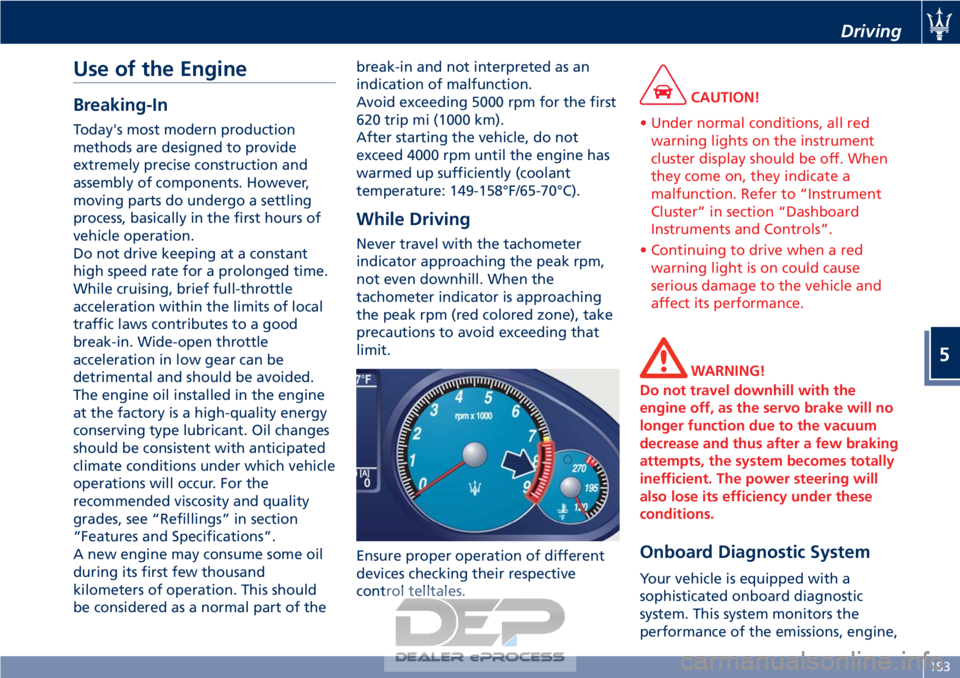
Use of the Engine
Breaking-In
Today's most modern production
methods are designed to provide
extremely precise construction and
assembly of components. However,
moving parts do undergo a settling
process, basically in the first hours of
vehicle operation.
Do not drive keeping at a constant
high speed rate for a prolonged time.
While cruising, brief full-throttle
acceleration within the limits of local
traffic laws contributes to a good
break-in. Wide-open throttle
acceleration in low gear can be
detrimental and should be avoided.
The engine oil installed in the engine
at the factory is a high-quality energy
conserving type lubricant. Oil changes
should be consistent with anticipated
climate conditions under which vehicle
operations will occur. For the
recommended viscosity and quality
grades, see “Refillings” in section
“Features and Specifications”.
A new engine may consume some oil
during its first few thousand
kilometers of operation. This should
be considered as a normal part of thebreak-in and not interpreted as an
indication of malfunction.
Avoid exceeding 5000 rpm for the first
620 trip mi (1000 km).
After starting the vehicle, do not
exceed 4000 rpm until the engine has
warmed up sufficiently (coolant
temperature: 149-158°F/65-70°C).
While Driving
Never travel with the tachometer
indicator approaching the peak rpm,
not even downhill. When the
tachometer indicator is approaching
the peak rpm (red colored zone), take
precautions to avoid exceeding that
limit.
Ensure proper operation of different
devices checking their respective
control telltales.
CAUTION!
• Under normal conditions, all red warning lights on the instrument
cluster display should be off. When
they come on, they indicate a
malfunction. Refer to “Instrument
Cluster” in section “Dashboard
Instruments and Controls”.
• Continuing to drive when a red warning light is on could cause
serious damage to the vehicle and
affect its performance.
WARNING!
Do not travel downhill with the
engine off, as the servo brake will no
longer function due to the vacuum
decrease and thus after a few braking
attempts, the system becomes totally
inefficient. The power steering will
also lose its efficiency under these
conditions.
Onboard Diagnostic System
Your vehicle is equipped with a
sophisticated onboard diagnostic
system. This system monitors the
performance of the emissions, engine,
Driving
5
183
Page 218 of 296

Engine Overheating
To reduce potentially overheating of
the engine in city traffic, while
stationary, place the transmission in N
(Neutral), but do not increase the
engine idle speed.
NOTE:
There are steps that you can take to
slow down an impending overheat
condition:
•If your air conditioner (A/C) is on,
turn it off. The A/C system adds heat
to the engine cooling system and
turning the A/C off can help remove
this heat.
• You can also turn the temperature
control to maximum heat, the mode
control to floor and the blower
control to high. This allows the
heater core to act as a supplement to
the radiator and aids in removing
heat from the engine cooling system.
CAUTION!
Driving with a hot cooling system
could damage the engine. If the
temperature gauge is positioned on
the red zone (refer to “Instrument
Cluster” in section “Dashboard Instruments and Controls”), pull over
and stop the vehicle. Idle the vehicle
with the air conditioner turned off
until the temperature gauge drops
back into the normal range. If the
temperature gauge remains on the red
zone turn the engine off immediately
and contact the
Authorized Maserati
Dealer.
WARNING!
You or others can be badly burned by
hot engine coolant (antifreeze) or
steam from your radiator. If you see or
hear steam coming from under the
hood, do not open it until the radiator
has had time to cool.
Never try to open a coolant bottle
pressure cap (refer to “Maintenance
Procedures” in section “Maintenance
and Care”) when the radiator is
overheated.
In case of a Punctured Tire
The vehicle can be equipped with a
tire repair kit or with a compact spare
wheel.
Using Tire Repair Kit
Small punctures up to 1⁄4” (6 mm) in
the tire tread can be sealed using the
tire repair kit, fitted beneath the floor
panel of the trunk compartment.
The kit comes in a bag and consists of
two parts:
• an electric compressor with pressure gage, hose to be connected to the
punctured tire and power cable;
• a gas cylinder containing sealant.
In an Emergency
6
214
Page 241 of 296
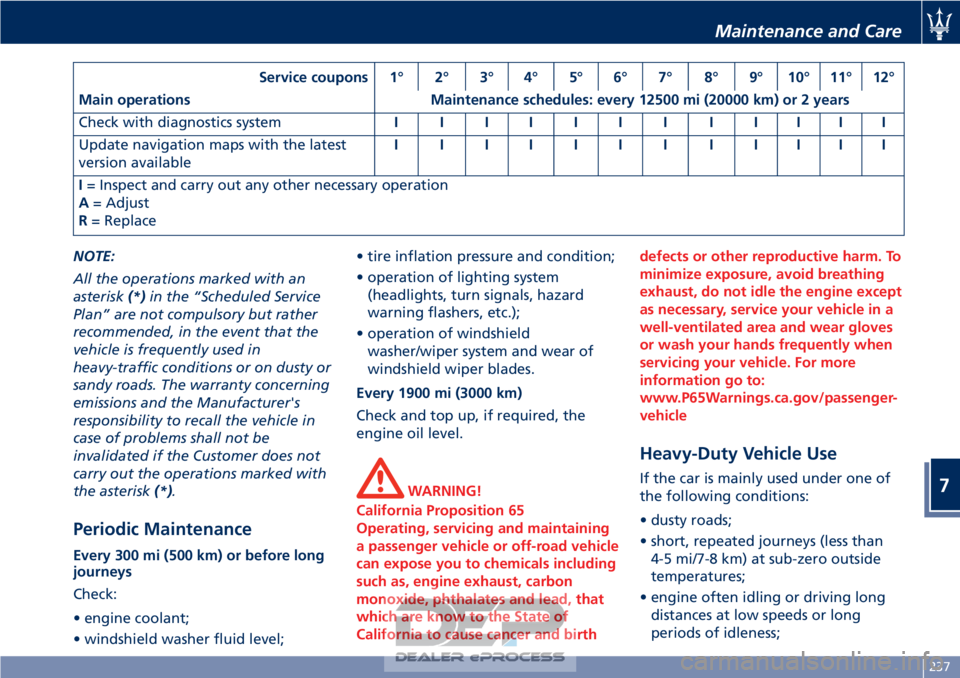
Service coupons 1° 2° 3° 4° 5° 6° 7° 8° 9° 10° 11° 12°
Main operations Maintenance schedules: every 12500 mi (20000 km) or 2 years
Check with diagnostics system IIIIIIIIIIII
Update navigation maps with the latest
version available IIIIIIIIIIII
I = Inspect and carry out any other necessary operation
A = Adjust
R = Replace
NOTE:
All the operations marked with an
asterisk (*)in the “Scheduled Service
Plan” are not compulsory but rather
recommended, in the event that the
vehicle is frequently used in
heavy-traffic conditions or on dusty or
sandy roads. The warranty concerning
emissions and the Manufacturer's
responsibility to recall the vehicle in
case of problems shall not be
invalidated if the Customer does not
carry out the operations marked with
the asterisk (*).
Periodic Maintenance
Every 300 mi (500 km) or before long
journeys
Check:
• engine coolant;
• windshield washer fluid level; • tire inflation pressure and condition;
• operation of lighting system
(headlights, turn signals, hazard
warning flashers, etc.);
• operation of windshield washer/wiper system and wear of
windshield wiper blades.
Every 1900 mi (3000 km)
Check and top up, if required, the
engine oil level.
WARNING!
California Proposition 65
Operating, servicing and maintaining
a passenger vehicle or off-road vehicle
can expose you to chemicals including
such as, engine exhaust, carbon
monoxide, phthalates and lead, that
which are know to the State of
California to cause cancer and birth defects or other reproductive harm. To
minimize exposure, avoid breathing
exhaust, do not idle the engine except
as necessary, service your vehicle in a
well-ventilated area and wear gloves
or wash your hands frequently when
servicing your vehicle. For more
information go to:
www.P65Warnings.ca.gov/passenger-
vehicle
Heavy-Duty Vehicle Use
If the car is mainly used under one of
the following conditions:
• dusty roads;
• short, repeated journeys (less than
4-5 mi/7-8 km) at sub-zero outside
temperatures;
• engine often idling or driving long distances at low speeds or long
periods of idleness;
Maintenance and Care
7
237
Page 245 of 296
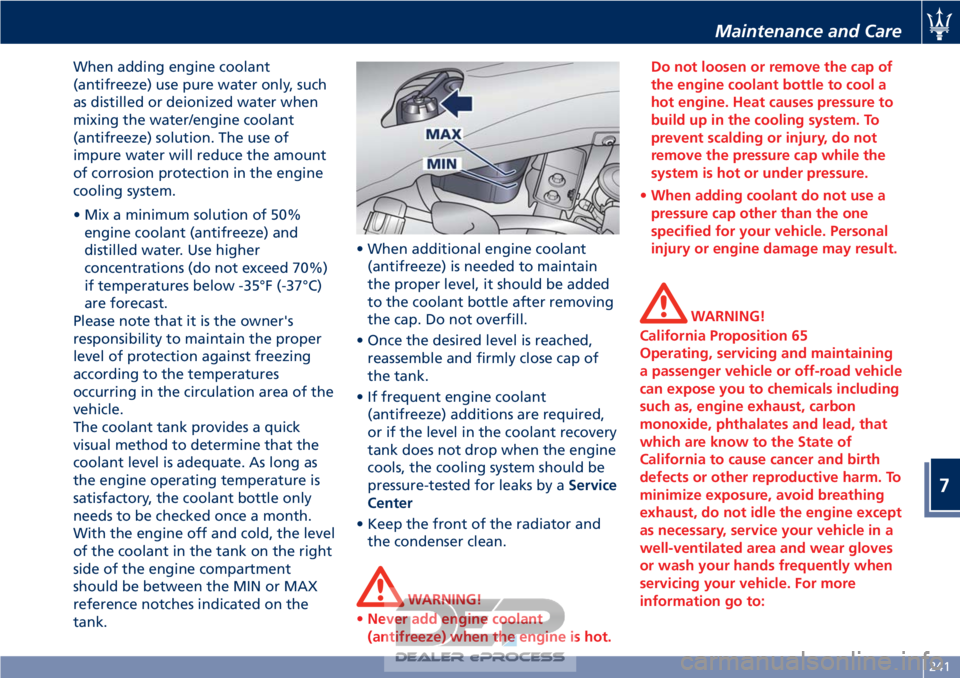
When adding engine coolant
(antifreeze) use pure water only, such
as distilled or deionized water when
mixing the water/engine coolant
(antifreeze) solution. The use of
impure water will reduce the amount
of corrosion protection in the engine
cooling system.
• Mix a minimum solution of 50%engine coolant (antifreeze) and
distilled water. Use higher
concentrations (do not exceed 70%)
if temperatures below -35°F (-37°C)
are forecast.
Please note that it is the owner's
responsibility to maintain the proper
level of protection against freezing
according to the temperatures
occurring in the circulation area of the
vehicle.
The coolant tank provides a quick
visual method to determine that the
coolant level is adequate. As long as
the engine operating temperature is
satisfactory, the coolant bottle only
needs to be checked once a month.
With the engine off and cold, the level
of the coolant in the tank on the right
side of the engine compartment
should be between the MIN or MAX
reference notches indicated on the
tank. • When additional engine coolant
(antifreeze) is needed to maintain
the proper level, it should be added
to the coolant bottle after removing
the cap. Do not overfill.
• Once the desired level is reached, reassemble and firmly close cap of
the tank.
• If frequent engine coolant (antifreeze) additions are required,
or if the level in the coolant recovery
tank does not drop when the engine
cools, the cooling system should be
pressure-tested for leaks by a Service
Center
• Keep the front of the radiator and the condenser clean.
WARNING!
• Never add engine coolant
(antifreeze) when the engine is hot. Do not loosen or remove the cap of
the engine coolant bottle to cool a
hot engine. Heat causes pressure to
build up in the cooling system. To
prevent scalding or injury, do not
remove the pressure cap while the
system is hot or under pressure.
• When adding coolant do not use a
pressure cap other than the one
specified for your vehicle. Personal
injury or engine damage may result.
WARNING!
California Proposition 65
Operating, servicing and maintaining
a passenger vehicle or off-road vehicle
can expose you to chemicals including
such as, engine exhaust, carbon
monoxide, phthalates and lead, that
which are know to the State of
California to cause cancer and birth
defects or other reproductive harm. To
minimize exposure, avoid breathing
exhaust, do not idle the engine except
as necessary, service your vehicle in a
well-ventilated area and wear gloves
or wash your hands frequently when
servicing your vehicle. For more
information go to:
Maintenance and Care
7
241